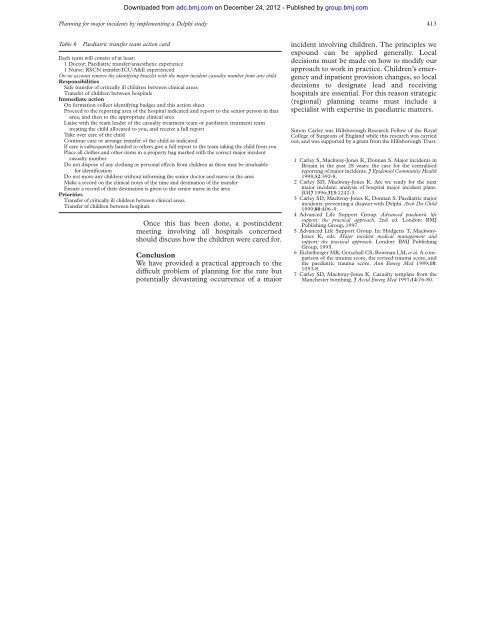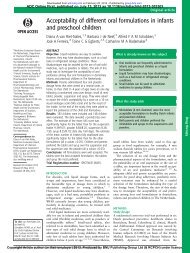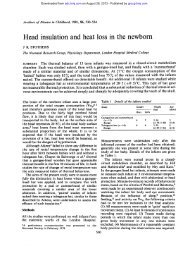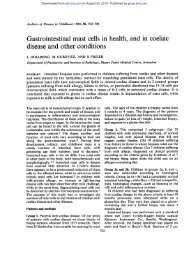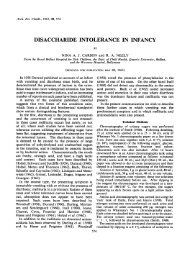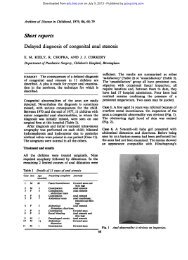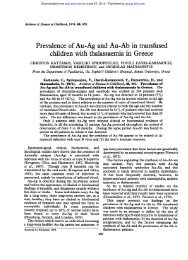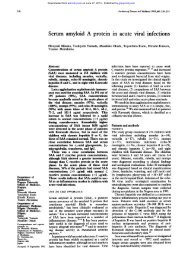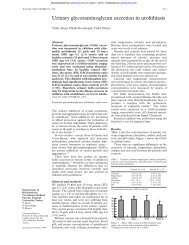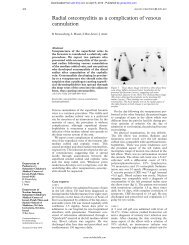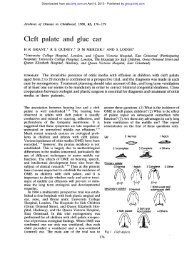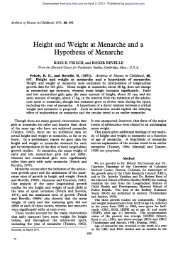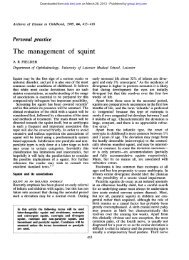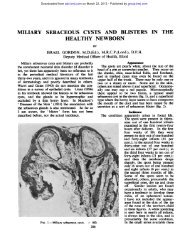Planning for major incidents involving children by ... - BMJ
Planning for major incidents involving children by ... - BMJ
Planning for major incidents involving children by ... - BMJ
You also want an ePaper? Increase the reach of your titles
YUMPU automatically turns print PDFs into web optimized ePapers that Google loves.
Table 6 Paediatric transfer team action card<br />
Downloaded from<br />
adc.bmj.com on December 24, 2012 - Published <strong>by</strong> group.bmj.com<br />
<strong>Planning</strong> <strong>for</strong> <strong>major</strong> <strong>incidents</strong> <strong>by</strong> implementing a Delphi study 413<br />
Each team will consist of at least:<br />
1 Doctor: Paediatric transfer/anaesthetic experience<br />
1 Nurse: RSCN transfer/ICU/A&E experienced<br />
On no account remove the identifying bracelet with the <strong>major</strong> incident casualty number from any child<br />
Responsibilities<br />
Safe transfer of critically ill <strong>children</strong> between clinical areas<br />
Transfer of <strong>children</strong> between hospitals<br />
Immediate action<br />
On <strong>for</strong>mation collect identifying badges and this action sheet<br />
Proceed to the reporting area of the hospital indicated and report to the senior person in that<br />
area, and then to the appropriate clinical area<br />
Liaise with the team leader of the casualty treatment team or paediatric treatment team<br />
treating the child allocated to you, and receive a full report<br />
Take over care of the child<br />
Continue care or arrange transfer of the child as indicated<br />
If care is subsequently handed to others give a full report to the team taking the child from you<br />
Place all clothes and other items in a property bag marked with the correct <strong>major</strong> incident<br />
casualty number<br />
Do not dispose of any clothing or personal eVects from <strong>children</strong> as these may be invaluable<br />
<strong>for</strong> identification<br />
Do not move any <strong>children</strong> without in<strong>for</strong>ming the senior doctor and nurse in the area<br />
Make a record on the clinical notes of the time and destination of the transfer<br />
Ensure a record of their destination is given to the senior nurse in the area<br />
Priorities<br />
Transfer of critically ill <strong>children</strong> between clinical areas<br />
Transfer of <strong>children</strong> between hospitals<br />
Once this has been done, a postincident<br />
meeting <strong>involving</strong> all hospitals concerned<br />
should discuss how the <strong>children</strong> were cared <strong>for</strong>.<br />
Conclusion<br />
We have provided a practical approach to the<br />
diYcult problem of planning <strong>for</strong> the rare but<br />
potentially devastating occurrence of a <strong>major</strong><br />
incident <strong>involving</strong> <strong>children</strong>. The principles we<br />
expound can be applied generally. Local<br />
decisions must be made on how to modify our<br />
approach to work in practice. Children’s emergency<br />
and inpatient provision changes, so local<br />
decisions to designate lead and receiving<br />
hospitals are essential. For this reason strategic<br />
(regional) planning teams must include a<br />
specialist with expertise in paediatric matters.<br />
Simon Carley was Hillsborough Research Fellow of the Royal<br />
College of Surgeons of England while this research was carried<br />
out, and was supported <strong>by</strong> a grant from the Hillsborough Trust.<br />
1 Carley S, Mackway-Jones K, Donnan S. Major <strong>incidents</strong> in<br />
Britain in the past 28 years: the case <strong>for</strong> the centralised<br />
reporting of <strong>major</strong> <strong>incidents</strong>. J Epidemiol Community Health<br />
1998;52:392-8.<br />
2 Carley SD, Mackway-Jones K. Are we ready <strong>for</strong> the next<br />
<strong>major</strong> incident: analysis of hospital <strong>major</strong> incident plans.<br />
<strong>BMJ</strong> 1996;313:1242-3.<br />
3 Carley SD, Mackway-Jones K, Donnan S. Paediatric <strong>major</strong><br />
<strong>incidents</strong>: preventing a disaster with Delphi. Arch Dis Child<br />
1999;80:406−9.<br />
4 Advanced Life Support Group. Advanced paediatric life<br />
support: the practical approach. 2nd ed. London: <strong>BMJ</strong><br />
Publishing Group, 1997.<br />
5 Advanced Life Support Group. In: Hodgetts T, Mackway-<br />
Jones K, eds. Major incident medical management and<br />
support: the practical approach. London: <strong>BMJ</strong> Publishing<br />
Group, 1995.<br />
6 Eichelberger MR, Gotschall CS, Bowman LM, et al. A comparison<br />
of the trauma score, the revised trauma score, and<br />
the paediatric trauma score. Ann Emerg Med 1989;18:<br />
1053-8.<br />
7 Carley SD, Mackway-Jones K. Casualty template from the<br />
Manchester bombing. J Accid Emerg Med 1997;14:76-80.


